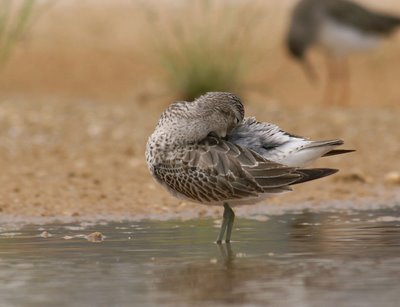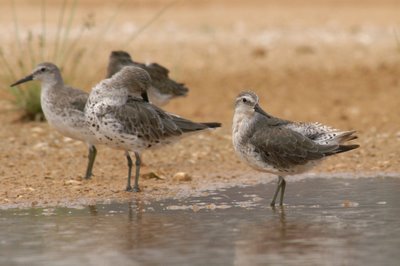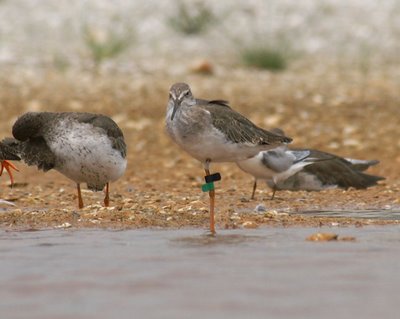
This juvenile/1st winter female Bar-tailed Godwit has a good shake after a bathe. Note the pristine secondaries. An adult would have at least some showing wear at this time.

The comparatively dark appearance of Whimbrels compared to Bar-tailed Godwits (behind) is a useful distinguishing feature at distance.

Synchronized swimming by a couple of Greenshanks!

The six visible inner primaries with white tips are freshly moulted; the two outer ones are old feathers (as can be seen from the brownish colouration, the ragged edges and the protruding quill of the longest one). Moult of the flight feathers starts in the middle of the wing (the outermost secondary and the innermost primary) and works progressively toward the innermost secondary and the outermost primary.

The extreme wear on the old feathers can been seen on this bird too - the longest primaries, the lowermost tertial, and a dark row of scapulars that are barely more than tatters. Both these birds are Greenshanks.

This preening juvenile Great Knot shows off its white rump - one of the differences between this species and Red Knot.

Another pic of the same juvenile Great Knot.

A couple of adult Great Knots, still with old breeding plumage breast feathers (with spots).

A good comparison of Red Knot (right) and Great Knot (left). One interesting structural difference is the shape and length of the nostril - longer in Great Knot and running more parallel to the culmen and cutting edge of the bill than Red Knot(you may need to click on the pic to enlarge it to see this!).

The shape of the nostril may be a useful feature when we are faced with some intermediate birds, like the out of focus bird on the left here. Is it a short-billed Great Knot or a long-billed (female) Red Knot? The nostril shape (just about discernible!) as well as the rather plain unstreaked plumage enable us to identify it as the latter.

One of my 5-star birds today wasn't a rarity at all, but a leg-flagged Redshank. By reporting the bird to the Australian Wader Studies Group, I was able to discover speedily that this 1st winter bird had been tagged earlier this autumn at Laem Phak Bia, in the south-west corner of the inner gulf of Thailand, approximately 868km away. This is the first sighting of a Thai-flagged bird away from the ringing area.

A study in relaxation! This Marsh Sandpiper does a passable phalarope impression!
No comments:
Post a Comment